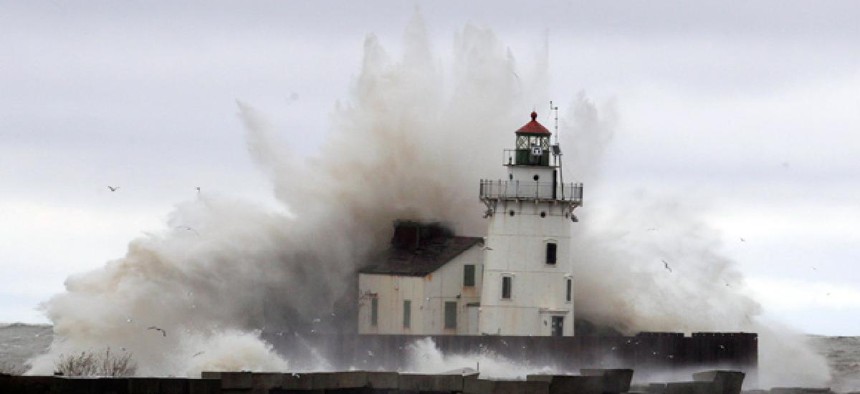The next Hurricane Sandy might come without a warning

Waves pound a lighthouse as Hurricane Sandy hits the shores of Lake Erie, Tuesday. Tony Dejak/AP
Experts say White House spectrum sharing plan could degrade weather forecasting, flood monitoring.
The Obama administration’s plan to share weather satellite frequencies with commercial cellular carriers could severely degrade scientists’ ability to forecast hurricanes and monitor flooding, weather and spectrum, experts told Nextgov.
The Federal Communications Commission proposed reallocating spectrum used by weather satellites in the 1675-1710 MHz band for commercial use in its 2010 National Broadband plan, a shift widely opposed by weather organizations worldwide.
FCC and the National Telecommunications and Information Administration narrowed the portion of the weather spectrum up for grabs to the 1695-1710 MHz band and endorsed sharing that band with commercial users at an August 2012 spectrum planning meeting.
John Snow, professor of meteorology at the University of Oklahoma, said this plan could interfere with the reception of data from sounding instruments on Geostationary Operational Environmental Satellites that measure atmospheric temperatures, cloud cover, moisture and humidity.
The National Weather Service cranks the data from these instruments into numerical models on its supercomputers to develop forecasts, including those used this week to predict the path of Hurricane Sandy, Snow said.
Weather satellite instruments play a key role in assessing conditions over oceans -- where hurricanes form -- as forecasters do not have any other means of measuring key parameters, as they do over land, Snow said.
The Weather Service also uses instrument data from the European Metop weather satellites. In 2010, Michel Jarraud, secretary general of the World Meteorological Organization, told FCC that reallocation of weather satellite spectrum could degrade the ability of forecasters to track hurricanes.
GOES transmits raw sounding data at a frequency of 1696 MHz and European satellites use downlink frequencies in the 1701-1707 MHz band. Snow said he does not believe the technology exists today that would allow sharing of weather satellite spectrum with cellular carriers without causing interference to what he called “key sensing systems.”
The spectrum sharing plan also could imperil signals transmitted from the GOES satellite for the Emergency Managers Weather Information Network, which transmits data at 1692.7 MHz and can be received on simple, inexpensive antenna systems connected to a PC. This data stream includes daily weather forecasts, severe storm warnings, flash flood warnings and even iceberg reports.
FCC wants to determine if weather satellite data could be downloaded to a small number of satellite dishes protected from interference by commercial cellular towers, with the data then transmitted over the Internet. Snow pointed out this approach would work only up until the point that rain flooded basements containing Internet hardware.
The U.S. Geological Survey operates a national network of 3,072 stream gauges to monitor water levels and potential floods, with data downlinked at a frequency of 1694.5 MHz from the GOES satellite, or just below the frequency FCC and NTIA want to share with commercial carriers.
Bernie Skoch, a telecommunications and computer consultant said this is too close for comfort, as poorly designed receivers could interfere with the signals. Robert Mason, acting chief of surface water for the Geological Survey, said any interference from commercial carriers “could put us out of business.”
Heather Phillips, an NTIA spokeswoman, said in an email statement that NTIA “recognizes the critical role that weather satellites play in tracking and monitoring potentially life-threatening storms, such as Hurricane Sandy. We are continuing our work to protect the critical sites that operate in the 1695-1710 MHz band, which have been identified for reallocation."
That’s not enough, said Skoch. In an era of climate change, weather satellites are mission-critical systems that need more -- not less -- spectrum, he said.
NEXT STORY: FTC takes on 'Rachel from cardholder services'






